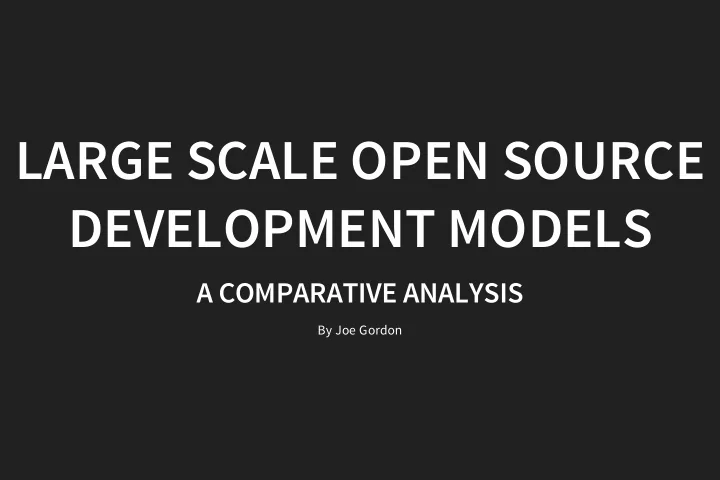

LARGE SCALE OPEN SOURCE DEVELOPMENT MODELS A COMPARATIVE ANALYSIS By Joe Gordon
WHY Saw OpenStack grow from around 60 developers to over 2,100 developers Unusual development model But how do other projects solve the same problems?
WHY IS PICKING THE RIGHT DEVELOPMENT MODEL IMPORTANT?
ACCELERATING GROWTH Time till 100 contributors Linux: 1991 - 2 years Linux 2.0 had 190 contributors in 1996 in credits OpenStack: 2010 - 1 year Docker: 2013 - several months over 300 contributors in its first year 200 contributors per month Linux: 1991 - June 2004 (13 years) Debian: 1993 - March 2007 (14 years) OpenStack: 2010 - October 2012 (2 years)
ACCELERATING GROWTH Linux, Debian, Docker, OpenStack (clockwise from top left) source: openhub
OPEN SOURCE IS BIG BUSINESS Open source is the new standard bodies Balancing corporate interests Linux foundation Gold and Platinum Members
PICKING THE RIGHT DEVELOPMENT MODEL CONWAY'S LAW organizations which design systems ... are constrained to produce designs which are copies of the communication structures of these organizations
DEVELOPMENT MODELS PROJECTS COVERED Linux Kernel Apache Software Foundation Debian OpenStack Docker
LINUX KERNEL
LINUX KERNEL Time based release 100-150 subsystem maintainers Chain of trust Decentralized review process Rolling development model
CULTURE Chain of trust About the individual Value frankness over politeness Corporate friendly No single company controls Not much automated pre commit testing Failing testing is very bad for author
APACHE SOFTWARE FOUNDATION
APACHE SOFTWARE FOUNDATION ASF is more of a governance umbrella and culture Separate projects 4,400+ committers 150+ top level projects flat (ish) trust model 'Review then commit' vs. 'commit then review' In order to reduce friction and allow for diversity to emerge, rather than forcing a monoculture from the top ... each project is delegated authority over development of its software, and is given a great deal of latitude in designing its own technic charter and its own governing rules.
CULTURE Lazy consensus Focus is on the team All decisions are team based Focus is on contributors not companies No monoculture Within the ASF we worry about any community which centers around a few individuals who are working virtually uncontested.
DEBIAN
DEBIAN When its ready, not time based. Notoriously slow Package Maintainers: No review, trust maintainers more
CULTURE Rotating leadership (elections) Do-ocracy: An individual Developer may make any technical or nontechnical decision with regard to their own work Open development Independent not 'profit-driven': no imposed decisions by who has money, infrastructure, people no benevolent dictator, no oligarchy It is all about the individual (although individual's can form groups) Territorial
OPENSTACK
OPENSTACK continuous delivery + stable releases No rolling development Break down into services and build teams around each service 5,000 commits per month from 500 contributors Strong centralized review process (two core reviews per patch) Automated testing to reduce reviewer burden Having trouble with scaling the team responsible for a single repository Can't get past 15 or so members on a core team
CULTURE Group over individual Egalitarian Elections Welcoming to new contributors Corporate friendly Not controlled by single company Lazy consensus Decentralized design Uniform tooling/process across projects
CULTURE OPENSTACK'S 4 OPENS Open Source , not open core Open Design Open Development Open Community Lazy consensus technical governance is a meritocracy put everything in the public
FACTORS LIMITING GROWTH Cross project issues Team size Single vision
DOCKER 'Github' development model
DOCKER Release every 2 months from stable branch (master isn't frozen) Scaling split into multiple repos Maintainers / subsystem maintainers 35+ maintainers in Docker 1) They share responsibility in the project's success. 2) They have made a long-term, recurring time investment to improve the project. 3) They spend that time doing whatever needs to be done, not necessarily what is the most interesting or fun." This "cellular division" is the primary mechanism for scaling maintenance of the project as it grows.
BDFL Ideally, the BDFL role is like the Queen of England: awesome crown, but not an actual operational role day-to-day. The real job of a BDFL is to NEVER GO AWAY. ... the BDFL will always be there, preserving the philosophy and principles of the project, and keeping ultimate authority over its fate. This gives us great flexibility in experimenting with various governance models, knowing that we can always press the "reset" button without fear of fragmentation or deadlock. See the US congress for a counter-example. BDFL daily routine: * Is the project governance stuck in a deadlock or irreversibly fragmented? * If yes: refactor the project governance * Are there issues or conflicts escalated by core? * If yes: resolve them * Go back to polishing that crown.
CULTURE Embraces the BDFL Open source Open design Docker the company dominates Most of the maintainers are docker employees Automated testing Be Nice and Encourage diversity and participation
THINGS TO CONSIDER FOR YOUR OWN PROJECT There is no one size fits all solution
WHAT DOES OPEN EVEN MEAN? Open Source Open Core Open Design Open Development Open Community
TOOLING CONSIDERATIONS Bug tracking Review process Testing Barrier to entry for new contributors DCO vs. CLA Developer Certificate of Origin Contributor Licensing Agreement Overall workflow
DEVELOPMENT MODEL COMPONENTS Communication Team scaling model chain of trust model flat trust model maintainers Release cadence Stabilization periods Rolling development CI/CD Number of artifacts Decision making process -- Consensus model Project culture
PROBLEMS SPECIFIC TO OPEN SOURCE BDFL Vision Managing competing interests Corporate Consensus model Trust and Ownership Team vs individual First come first serve? How do you fire someone?
THANK YOU QUESTIONS? Slides can be found at jogo.github.io/development-models Powered by reveal.js
Recommend
More recommend